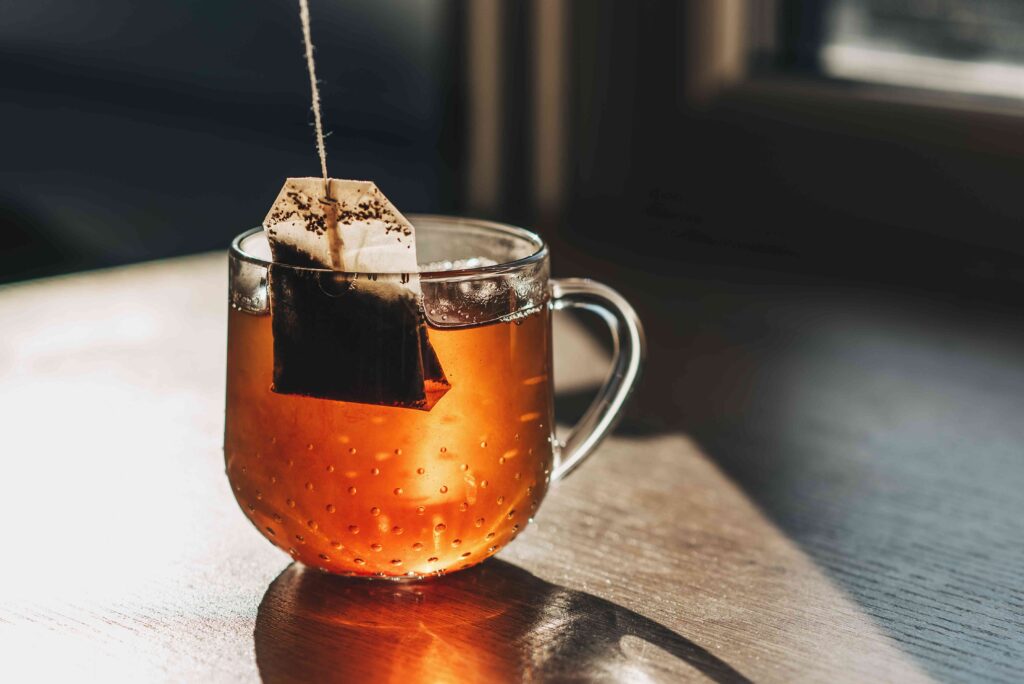:max_bytes(150000):strip_icc():format(jpeg)/Health-GettyImages-1471979246-51a0b5e3d2e04d4f9474df2b0e67123f.jpg)
Your favorite tea could be exposing you to billions of tiny plastic particles, new research finds.
In a November 2024 study published in Chemosphere, researchers tested three different brands of tea bags for exposure to microplastics—degraded plastic bits that don’t break down and are suspected to impact human health.
The team found that brewing tea in a plastic bag made of polypropylene, a common tea bag material, released over a billion particles per milliliter of tea. Paper tea bags made of cellulose and mesh nylon bags shed millions of plastic particles per milliliter.
“The fact that they did find so many of these micro and nanoplastics in a product that’s supposed to be consumed is potentially concerning,” John Meeker, ScD, CIH, a professor of Environmental Health Sciences and Global Public Health at the University of Michigan School of Public Health, told Health.
After extracting the plastics from the brewed tea, the researchers exposed them to human intestinal cells. The cells absorbed the plastic particles, suggesting that microplastics could remain in the body after drinking tea.
Study author Alba García-Rodríguez, PhD, a researcher in the Department of Genetics and Microbiology at the Universitat Autònoma de Barcelona, said the research calls attention to a path of substantial exposure to plastic particles in our everyday lives. “We have to be concerned about the huge number of single-use plastic that humans are exposed to daily,” she told Health.
This isn’t the only time researchers have examined tea bag microplastic exposure. A Canadian study from 2019 was the first to test nylon and polyethylene tea bags, revealing that they release a respective 11.6 billion microplastics and 3.1 billion nanoplastics—which measure less than a micron—into a single cup of tea.
Additional research supported the finding that tea bags can leach microplastics and nanoplastics, including a study from 2023 conducted by García-Rodríguez and colleagues. They tested one brand of tea bags made of polylactic acid, a biodegradable plant-based plastic, and found about 1 million nanoplastic particles were released per tea bag.
For the new study, the team wanted to examine different materials and get a larger sample to test with the human cells, García-Rodríguez said. They purchased empty tea bags made of three commonly used materials: polypropylene, nylon, and cellulose.
The team brewed the tea bags as a consumer would (minus the tea leaves) in sterile water heated to 95 degrees Celsius, or 203 degrees Fahrenheit, with constant stirring and then measured the number of plastic particles released.
Researchers found that the polypropylene bags released the most microplastic—about 1.2 billion particles. The paper cellulose bags followed, with 135 million particles per milliliter, and the mesh nylon bags leached 8.18 million.
The hot temperature, the water exposure—even the stirring of the spoon can cause tea bags to leach plastic, García-Rodríguez explained.
After characterizing the microplastics with a variety of advanced techniques, the scientists then exposed the plastic particles to human intestinal cells and tracked their interaction.
The cells absorbed the microplastics, and mucus cells, specifically, had the highest uptake of particles. After 24 hours, the plastic particles had reached the nucleus of the cells, which houses our DNA.
“The mucus is supposed to protect us from pathogens or external contaminants,” García-Rodríguez explained. “Actually, [the microplastics] were able to adhere stronger. So the mucus matter was nothing in terms of protection.”
Experts said the findings are concerning. After being ingested, the microplastics could target the tissues and organs in the gastrointestinal tract, Meeker explained. They could then enter the bloodstream and “get into circulation,” enabling them to infiltrate other tissues and organs throughout the body.
But what this means for our health is still an open question, and it would be “premature” to draw any conclusions based on current research, Ana Navas-Acien, MD, PhD, MPH, a Leon Hess Professor and Chair of Environmental Health Sciences at Columbia Mailman School of Public Health, told Health.
Although studies have linked chemicals added during plastic production with potentially serious problems, including endocrine system disruption and cancer, scientists still don’t fully understand the health impacts of ingested microplastics.
“Microplastic is such a large universe,” Meeker said. “The human studies are very much lacking today, and there’s much more need there.”
If you’d like to lower your microplastic exposure without giving up tea, the good news is that you have options.
García-Rodríguez recommended using loose-leaf tea with a stainless steel infuser or a reusable filter, also made of stainless steel.
Unfortunately, tea bags made of biodegradable plastic are unlikely to reduce your microplastic exposure, García-Rodríguez said. “They tell us that they are biodegradable, that they degrade easily. But because they do that, they also release even more nanoplastic,” she explained.
Plastic-free materials, like wood and cornstarch, will likely release less microplastic, if any. However, García-Rodríguez cautioned against any single-use or polymer-based materials, as they could still encounter plastic in production.
García-Rodríguez also recommended other ways to limit daily microplastic exposure, such as using glass food storage containers, avoiding plastic water bottles, and limiting the consumption of foods and produce wrapped in plastic.
“We’re not fighting against the plastic industry because we know that plastic has helped us a lot when it comes to food conservation and the security of food,” she said. “But we need to regulate the amount of plastic.”













